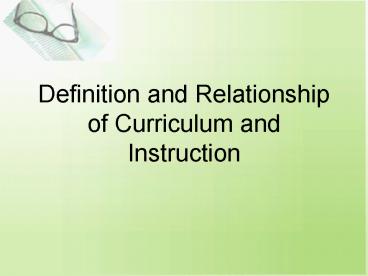Definition and Relationship of Curriculum and Instruction - PowerPoint PPT Presentation
1 / 13
Title:
Definition and Relationship of Curriculum and Instruction
Description:
... serve on a curriculum team one day or create your own modified ... Finch, C.R. and ... our new courses being developed using Bloom's new revised ... – PowerPoint PPT presentation
Number of Views:2608
Avg rating:3.0/5.0
Title: Definition and Relationship of Curriculum and Instruction
1
Definition and Relationship of Curriculum and
Instruction
2
Levels of Curriculum
- Societal- political
- Institutional- local educators and laypeople
- Instructional- teachers plan and deliver
- Experiential- perceived and experienced by
students - Goodlad and Su (1992)
3
Levels of Curriculum
- Based on how far the learner is from the source
of the decisions made about the curriculum. - For example
- President Obama makes decisions at the societal
level- he is currently influencing the future of
No Child Left Behind. - State staff make decisions at the institutional
level by deciding what courses are taught in
agricultural education. - Teachers make instructional decisions when they
create instructional plans.
4
WHAT is taught to students.
What is curriculum?
There are many definitions that are correct.
but for our purposes we define curriculum as
5
What is curriculum development?( sometimes
called macrocurriculum)
- In this course when we refer to curriculum
development, we are assuming the process involves
a number of professionals and the curriculum that
is produced will be used by multiple instructors.
6
So why are you here?
- Because you may want to serve on a curriculum
team one day or create your own modified course
or program for adoption by the state.
7
What is instructional design? (sometimes called
microcurriculum)
- Instruction is HOW the curriculum is delivered to
students. - Instructional design typically occurs when an
instructor is preparing to teach his or her
courses or program.hopefully you already know
how to do this.
8
Shared Aspects and Unique Aspects of Each
Finch, C.R. and Crunkilton,J.R. (1999).
Curriculum Development in Vocational and
Technical Education,p.13.
9
Technical Approach
Rational Logical Process
- The traditional approach
- Typically a committee of state leaders, teachers
and industry personnel - Assumes the teacher will accept the revisions
- Evaluation is based on the faithfulness of the
implementers - Use is called implementation
10
Technical Approach
Non-rational Process
- Implementers (teachers) collaborate with
developers - This adaptation gives the teachers a feeling of
ownership - Evaluation is based on meeting the intended
purposes of the curriculum and the implementers
actual use of the curriculum - Use is called implementation
11
Non-technical Approach
- Based on the individual needs of the student or
society - The teacher makes the decisions as the subject is
taught - Evaluation is based on meeting its intended
purpose - Use is called enactment
12
Curriculum Terms
- Curriculum products include course blueprints,
courses of study, resource units, list of goals
and objectives, and in NC- instructional
outlines. These include any documents produced by
curriculum developers that deal with the content
to be taught. - Curriculum guides usually include the content to
be taught and instructional strategies to be used
(lesson plans). In NC, our new courses being
developed using Blooms new revised taxonomy will
have a curriculum guide (we will discuss this
more later in the course) not just a course
blueprint. - Curriculum resources usually include things such
as textbooks, content brochures ( think of a 4-H
project book), videos, and computer software or
internet sites that instructors use to support
the course.
13
Summary
- In this course, we will carry out the curriculum
development process to create a new course by
conducting a needs assessment for the course,
developing a course blueprint, and selecting
instructional/curriculum products to be used when
teaching the course. - We will be using different rational logical
process of the technical approach to do this.

